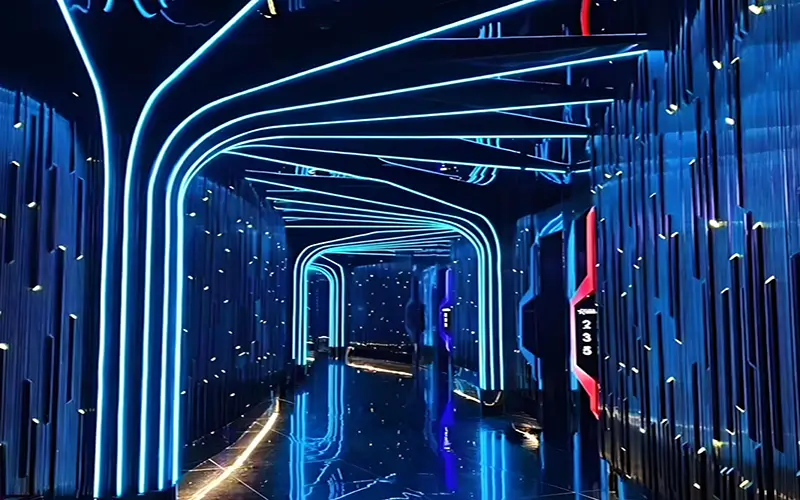
Energieeinsparung und nachhaltige Entwicklung sind wichtige Punkte, die bei modernen Beleuchtungssystemen eine Rolle spielen. Die Beleuchtung ist ein wichtiger Aspekt unseres täglichen Lebens, etwas, auf das wir alle angewiesen sind. Sie macht einen großen Teil des Energieverbrauchs aus. Dies hat zu einem wachsenden Interesse an LED-Beleuchtung geführt, die als energieeffizientere Alternative zu herkömmlichen Beleuchtungsquellen angesehen wird. Verbrauchen LED-Leuchten also weniger Strom?
Wie LED-Leuchten Energie sparen?
LED-Leuchten sind energieeffizienter als herkömmliche Leuchtmittel. Dies ist vor allem auf ihr fortschrittliches technisches Design und ihr effizientes Funktionsprinzip zurückzuführen.
Höhere Energie-Effizienz Umwandlung
LED (Light Emitting Diode) ist eine Technologie, die elektrische Energie effizient in Lichtenergie umwandelt. LED-Lampen wandeln elektrische Energie direkt in Lichtenergie um, erzeugen fast keine Wärme und sind 8 bis 10 Mal energieeffizienter als Glühlampen. Herkömmliche Glühlampen geben ihr Licht durch Erhitzen des Glühfadens ab, ein Prozess, der viel Wärmeenergie erzeugt und somit einen Großteil der elektrischen Energie vergeudet. Daher können LED-Lampen bei gleichem Stromverbrauch eine höhere Lichtleistung erzielen.
Niedriger Stromverbrauch
Der Energiebedarf von LED-Lampen ist viel geringer als der von herkömmlichen Lampen. Der Leistungsbereich von LED-Lampen liegt in der Regel zwischen einigen Watt und einigen zehn Watt, was viel niedriger ist als bei herkömmlichen Lampen und weniger Strom verbraucht.
Längere Nutzungsdauer
Die Lebensdauer von LED-Lampen liegt in der Regel zwischen 25.000 und 50.000 Stunden, während die Lebensdauer herkömmlicher Glühlampen meist nur 1.000 bis 2.000 Stunden beträgt. Dies kann den ständigen Austausch und die Wartung reduzieren, was den Energieverbrauch und die Ressourcenverschwendung weiter verringert.
Verringern Sie den Wärmeverlust
LED-Leuchten erzeugen im Betrieb nur sehr wenig Wärme. Dieser wärmearme Betrieb senkt nicht nur den Energieverbrauch, sondern verringert auch den Bedarf an Kühlgeräten wie Klimaanlagen, was indirekt zu weiteren Energieeinsparungen führt.
Wie verbessern LED-Leuchten die Energieeffizienz?
Die LED-Technologie hat sich in den letzten Jahren kontinuierlich weiterentwickelt, und die Hersteller haben durch Innovationen die Effizienz ihrer Produkte erheblich verbessert. Die heutigen LED-Glühbirnen sind energieeffizienter und leistungsfähiger als in der Vergangenheit. Dies wird durch die Verwendung fortschrittlicherer Halbleitermaterialien, ein optimiertes Schaltungsdesign und ein verbessertes Wärmemanagement erreicht.
Der Schlüssel zur Energieeffizienz von LED-Leuchten liegt in den Eigenschaften ihrer gerichteten Lichtemission. Im Gegensatz zu herkömmlichen Glühbirnen, die Licht in alle Richtungen ausstrahlen, fließt der Strom bei LEDs nur in eine Richtung, so dass keine Reflektoren und Diffusoren zum Sammeln des Lichts erforderlich sind, was die Energieeffizienz verbessert und die Energieverschwendung verringert.
Was sind die Vorteile von LED-Leuchten mit reduzierter Wärmeentwicklung?
Ein weiterer Vorteil von LED-Leuchten ist, dass sie weniger Wärme erzeugen. Warum ist weniger Wärme eine gute Sache? Weil Glühlampen beim Betrieb viel Wärme erzeugen, wodurch Energie verschwendet wird. Im Gegensatz dazu erzeugen LED-Leuchten nur sehr wenig Wärme, so dass sie effizienter arbeiten können. Das spart nicht nur Energie, sondern ist auch sicherer.
Die geringere Wärmeentwicklung der LEDs hat auch viele praktische Vorteile. So können LEDs beispielsweise in sensiblen Umgebungen eingesetzt werden, in denen Wärme Schäden oder Unbehagen verursachen könnte. Beispiele hierfür sind Kunstgalerien, Kühllager und beengte Räume. Darüber hinaus verlängert die niedrigere Betriebstemperatur von LEDs ihre Lebensdauer, da sie weniger anfällig für Überhitzungsschäden sind.
LED-Leuchten im Vergleich zu herkömmlicher Beleuchtung
LED-Lampen sind wesentlich energieeffizienter als herkömmliche Lichtquellen. Herkömmliche Glühlampen wandeln nur etwa 10% des Stroms in Licht um, der Rest wird als Wärme verschwendet.
Im Gegensatz dazu haben LED-Lampen den entscheidenden Vorteil, dass sie bis zu 90% des Stroms in Licht umwandeln können, was sie wesentlich energieeffizienter macht als Glühlampen.
LED-Lampen sind nicht nur stromsparender, sondern halten auch viel länger als herkömmliche Glühbirnen. Glühlampen halten etwa 1.000 Stunden, Leuchtstofflampen etwa 10.000 Stunden, und LED-Lampen halten in der Regel 25.000 bis 50.000 Stunden oder sogar noch länger.
Entscheiden Sie sich für LED-Leuchtbänder für eine kostengünstigere Beleuchtung
Wenn Sie ein Unternehmen sind oder auf der Suche nach energiesparenden LED-Lichtleisten sind, können Sie sich an uns wenden, Neonstreifen ist ein Hersteller, der sich auf die Produktion von LED-Streifen und Neon-Flex.
Wir bieten kommerzielle LED-Streifen wie SMD und COB-LED-Streifen und Neon Flex, mit einer 5-Jahres-Garantie, damit Sie sich keine Sorgen machen müssen!
